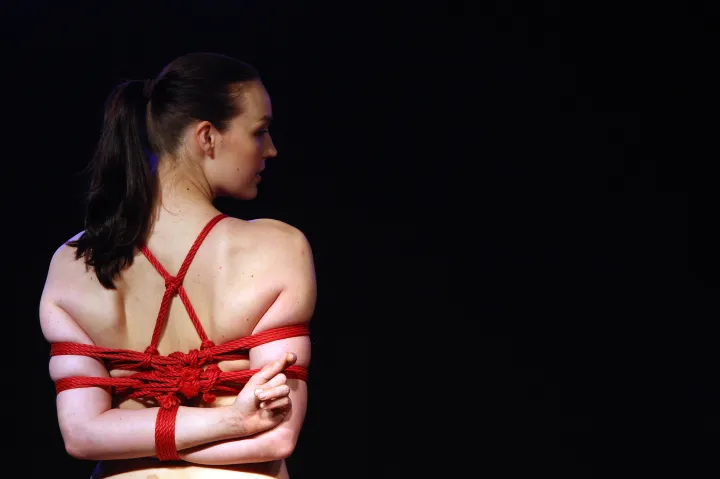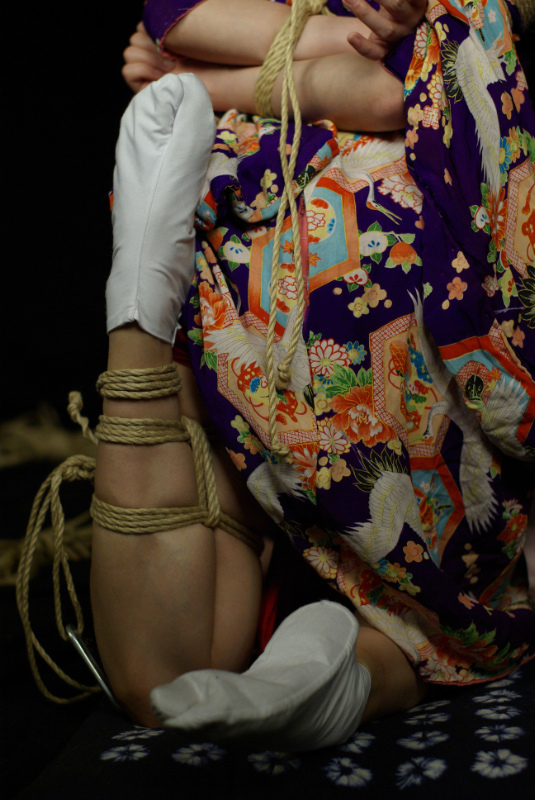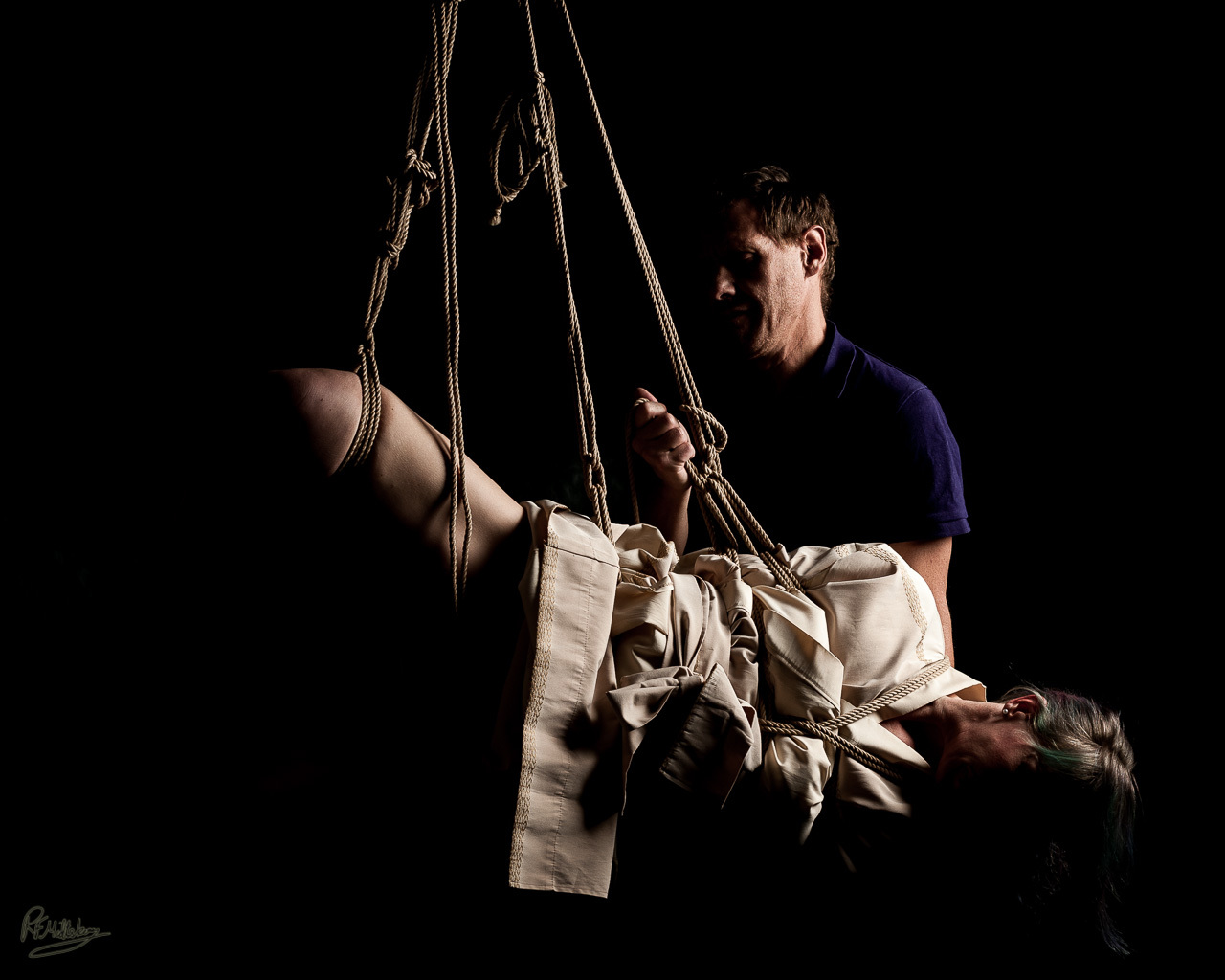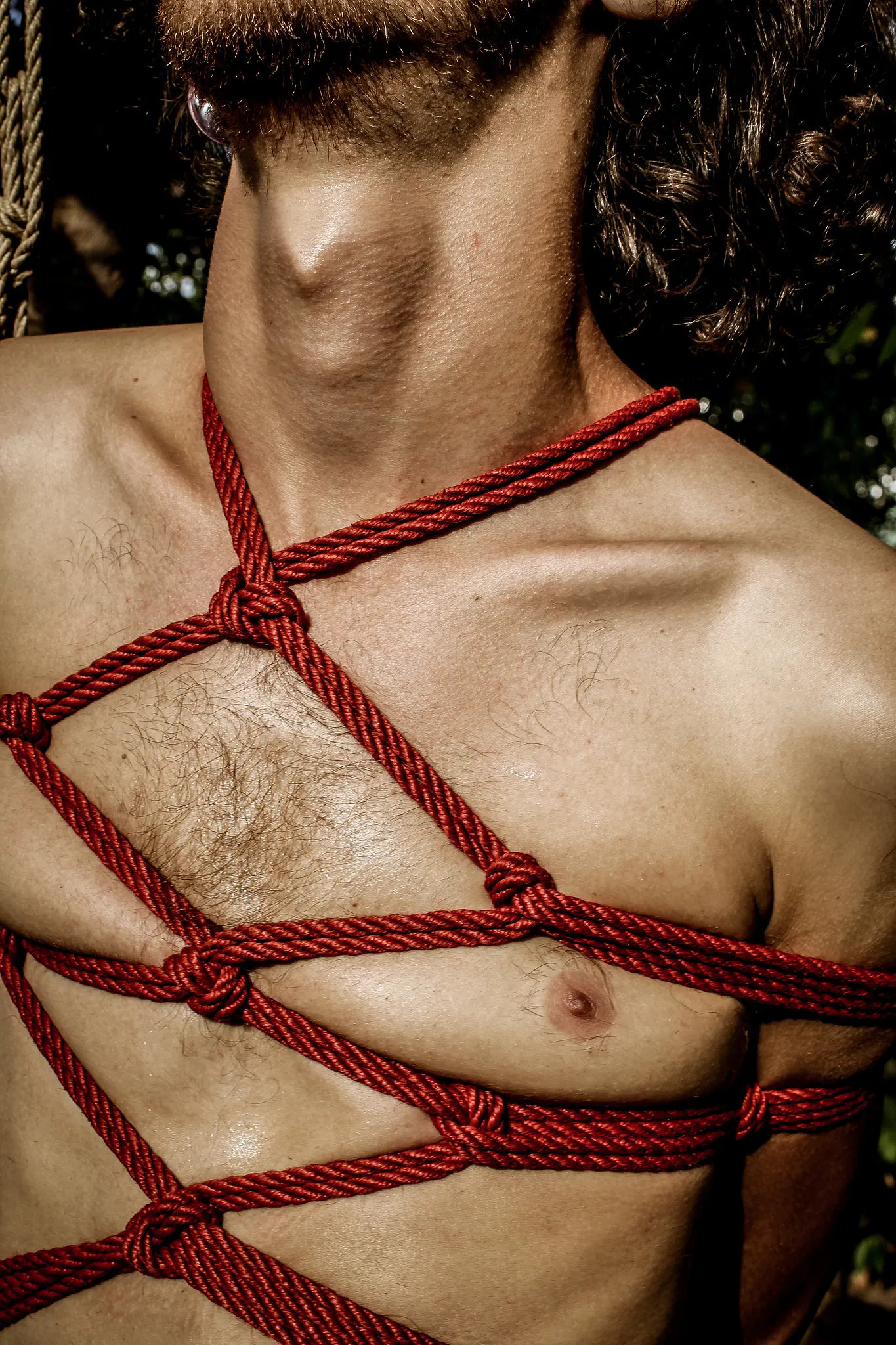MATTERS OF OBSESSION
The journey of a rope bondage practitioner and teacher

Over the past two decades, rope bondage has grown in popularity and mainstream visibility. Maverick Life caught up with Astrid, a Cape Town-based bondage practitioner and teacher, to chat about her bondage journey, as well as her work towards building a safer and more inclusive bondage community.
“My approach is actually quite wholesome. Bondage can be shadowy work, there’s a lot of stuff there that is revealed with the rope. But my sort of entry point, especially for new people, is to communicate that this is actually about communication; it’s about trust; it’s about self-advocacy; it’s about creativity and joy and pleasure. Those are the kind of words I use when I talk about bondage,” explains Astrid, a Cape Town-based 29-year-old bondage practitioner and teacher. In July 2020, together with her wife, Simone, they founded Embodiment, a rope bondage practice as well as a physical space based in an industrial building in Salt River, Cape Town, where they run workshops, rope jams, private lessons, sessions and photoshoots.

Rope bondage teacher Astrid with model Dominique Amanda. (Photo: Kye Vogel-Du Plessis)
Astrid’s journey into the world of “kink” began in 2015. Her boyfriend’s sister at the time invited her to a kink party in Tokai. “I thought: Oh, that sounds very exciting. Let me go and do some, like, anthropological research,” she says. Once there, she found herself drawn to the “honesty” and the way people were “just expressing themselves at kink parties”. However, she had some reservations; she was uncomfortable with the homogeneity of the parties. As she describes it, “the kink scene was, and is, very white, cis, able-bodied, heteronormative, straight, middle-aged”. Still, she found the essence of it to be very wholesome, pleasure-centric, body-positive, “and also problematic, there were problematic elements, but there was a lot of beauty there as well”.
She continued attending the parties, “getting spanked and tied up”. The following year, she moved to Australia, at first for three months as part of her studies towards her master’s degree, and later her PhD. As a way to meet people and socialise, she explored online kink forums and found her way into the kink scene. “And that’s when I discovered Shibari,” says Astrid, referring to the Japanese practice of rope bondage. Upon her return to Cape Town, she founded Ropey Things in 2017, a “sort of peer-to-peer learning environment for rope”, together with other people in the city that knew were into bondage. “We started giving these workshops together, where we would teach specific ties, and a little bit about consent, safety and negotiation. From the get-go, it was a very educational thing for me… I’d discovered this thing that I love, and I wanted to bring it back and teach other people how to do it in a safer way. We tied and taught around the city for a few years and then eventually this collective morphed into the physical rope space we have now,” says Astrid.

Model Dominique Amanda. (Photo: Kye Vogel-Du Plessis)
The word Shibari literally means “to tie”. According to the book, Essence of Shibari: Kinbaku and Japanese Rope Bondage, “in current English vernacular, shibari often gets used in reference to Westernised Japanese aesthetic ropework, while kinbaku is used for Japanese work done in Japan. However, both terms are used in Japan at this time.”
“When I was first [introduced to bondage] here in South Africa, I was exposed to a more Western-style bondage. The Japanese aesthetic is more sort of perfectionistic… there are certain aesthetic principles,” Astrid explains. While the eroticised practice of bondage is a relatively recent practice, having been established in the late 19th to early 20th century, its roots are often traced back to Japan’s Edo era, the period between 1603 and 1867. Back then, captives we restrained and sometimes tortured using rope. At the end of the 19th century, rope bondage started popping up in kabuki theatre. By the mid-20th century, bondage photography and illustrations were published in fetish magazines on both sides of the Pacific.

Image: flick.com
When asked about the differences between Western and Japanese bondage, Midori, the sex educator and mononymous author of the 2002 title The Seductive Art of Japanese Bondage, largely regarded as one of the most influential books on Shibari in the West, advises caution about making too much of Shibari’s military origins: “Every culture has its darker part of its history of human conflict, and that also echoes into our darker erotic desires… So when you think of conventional BDSM like handcuffs, right? What’s the origin of handcuffs? Origin of handcuffs is law enforcement and incarceration by police… Those tools end up becoming tools of fantasies for our kinky little sex games,” Midori explains.
She argues then that the aesthetics of Japanese Bondage are culturally specific because of the role that rope and knots have played not only in the restraint and torture of prisoners but also in Japanese culture generally: “Aesthetics are different indeed. And that’s also culturally specific as well. So don’t so much look at.. okay, the tools. The tools that are used are different because of the cultural framework. In the West, you have metal-based bondage because think in terms of medieval use of metal implements. Metal and wood. Right? Think medieval as the Spanish inquisition… And you get the handcuffs because of cops. So the tools are the tools of incarceration specific to the culture… Whereas in Japan think of rope as an extension of wrapping. Or rather a subcategory of wrapping. Everything in Japan is wrapped… Gifts are wrapped, origami is wrapping, the national traditional garment, the Kimono, is actually a series of wrapping. It is a culture that is obsessed with wrapping. And so, why wouldn’t you also wrap your sweetie before you have hot, dirty sex?”

Image: flick.com
While sex and eroticism form a big part of Midori’s practice, Astrid notes that the experience of bondage and the expectations are different for everybody. “But I would say there are some general themes. We call our rope space in Cape Town, Embodiment because we wanted to sort of reflect the sensation of being contained, being embodied, being brought into your body and out of your mind. So I would say one of the overarching themes is this presence within your body, almost like a mindfulness practice.” That said, she emphasises the validity of different approaches to rope bondage: “It can be erotic, playful, creative, shameful, subversive, soothing, reassuring. Emotion is output by the person tying, through their movements and how they lay the rope. The job of the receiver is to be present in their body, be aware of what they are receiving and transmit emotion back. Rope is a lot like dance in this way. There is a leader and a follower, an exchange of emotion and co-creation of something meaningful.”
Similarly to mindfulness practice, she notes that intention plays a key role in each session. As bondage is an integral practice in her relationship with her wife Simone, upfront negotiation around intention and consent is also an important part of each session. Says Astrid: “When Sim and I want to tie together, I’ll be like, ‘What are you feeling today?’, and she might express that she wants a loving, celebratory, caressing tie, or she really wants to be pushed. So then whatever we do, flows from that intention; however long I might leave her there, in that predicament, in that challenging position, will flow from that intention. Tying is almost as intimate as someone picking your clothes for the day, and then putting the clothes on your body and then…” Simone finishes the sentence, “… taking them off at the end of the day, and you have to walk around and whatever they’ve put you in. And it could be something like absurd, it could be something really uncomfortable.”
However, some practitioners also like to practice self-tying as a solo experience. The popular Shibari subscription app founded in 2019, Shibari Study, offers a wide range of videos to stream, including performances by advanced practitioners, as well as beginner lessons covering theory, the rope itself, types of knots, and a diverse section of Shibari practices from suspension to floor tying. In one of the videos, presented by Shibari teacher Anna Bones, and titled The Pleasure of Self-Tying, she states: “I like self-tying because it’s a space where I can be with myself, without judgement, and being fully present and not really thinking about anything else other than what I’m doing… It’s really creative as well, and you can take a lot of liberties.”
Simone also enjoys solo tying because she likes to push herself mentally and physically. “And there’s a lot I can do by myself. But there’s an element to introducing another person and relinquishing the control to them, that enables me to dig deep into myself and access places that I can’t normally access by myself. I think it’s the same for a lot of other people, and it gives them that sense or feeling that they are embodied; a feeling of mental clarity and a deeper sense of being in touch with themselves, as well as the people around them.”

Image: flickr.com
While the couple says they work to engender a spirit of trust, respect and communication in their practice with each other, in the community that is part Embodiment, as well as with private clients looking to either be tied or learn how to tie, they emphasise that the world of bondage is not without its issues. “People tend to think that kink is like a utopia where everybody is superconsensual and supercommunicative. It can be, but for the most part, I would say, kinky people are just like vanilla people in the sense that they also struggle with communication; they also struggle to set boundaries. There are also predatory people in that scene,” Astrid explains.
Another concern for the couple is the tendency among some participants to want to separate identity and politics from their pleasure, specifically the way some people speak about their kink online, seek out potential suitors and organise events, is not with inclusion in mind. These range from people who might want to see the space as one where classism and racism doesn’t exist, through to the kind who might want to indulge in racialised slave-master role play. “When you start to challenge them, they’re like, ‘No, no, no, this is a space of utopia. This is our sacred safe world, and everything is finely negotiated and perfect’. They want to dominate a woman, or they want to dominate a queer person, or they want to be sissified. Play that involves identity is fine — sometimes playing with tropes or stereotypes in a conscious way enables you to challenge them. The issue comes in when the assumptions you have about those identities go unchallenged and you are literally indulging in racist, sexist, classist, ableist stereotypes,” says Astrid.
Much like the controversial “No fats, no fems, no Asians, no blacks” disclaimers sometimes seen on profiles on dating and hook-ups apps like Grindr, in the “broader kink community” there are also practitioners who express a strict preference to only “play” with people of their race. “However, one wonderful thing about the kink spaces is that there is a lot of focus on building community because community does keep us safe. That way you’re able to get rid of the toxic elements, and it does work. But that only happens when somebody already sort of oversteps a boundary. It’s very reactive rather than proactive,” Astrid explains.

Image: flickr.com
As part of the mission to build a safer and more inclusive rope bondage community, together with collaborators, she has been offering introductory workshops, “where self-care, consent, boundaries and negotiation techniques are discussed and explored with practical examples. We have also launched a kink market that happens once every two months where people can come and browse kinky wares, chat to practitioners, get spanked, tied and practice consent all in the light of day rather than at a kink party where no effort is made towards education. We are working really hard to make our scene more proactive about safety and consent than reactive to abuse.”
Another visible advantage of the growing community around bondage is perhaps the decreasing stigma around the practice. Fellow practitioners and members of the local bondage community have open Instagram and Facebook pages where they are able to share images and insights from their practices. For example, Embodiment’s own Instagram page, @embodiment_ct, or their collaborators and friends such as sex educator and bondage practitioner Tapiwa’s page, @sungakonji. And unlike the homogeneity Astrid experienced upon her entry into the kink scene, this community is far more diverse. That said, and even though both Astrid and Simone are quite open about their practice, they did ask that we use only their first names for the article, as certain prejudices towards rope bondage still prevail, and as Astrid puts it, “If I’m doing freelance work, and someone happens to google me for that, I don’t necessarily want ‘bondage girl’ to be the first thing they see about me. But I am really proud of our community and the work we have collectively done to make it safer and more wholesome.” DM/ML


















 Become an Insider
Become an Insider
Comments - Please login in order to comment.